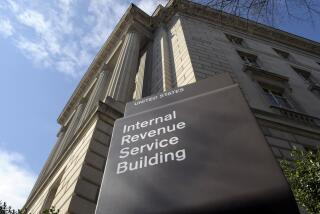Fed Sees Budget Surplus Swelling to $50 Billion
- Share via
WASHINGTON — The surging U.S. economy is likely to push the federal budget surplus to at least $50 billion for the current fiscal year, according to an internal Federal Reserve projection. And other estimates show that the total could soar to $75 billion or more if current spending and revenue trends continue.
The looming surpluses are so large, analysts said, that the president and Congress may have the resources much earlier than they expected to begin to plug the shortage in the Social Security trust fund, cut taxes or increase other spending programs.
The new projections piggyback the latest in the series of sterling economic data that signal inflation remains in check. On Thursday, the Labor Department reported that prices paid to U.S. producers fell in the first quarter at the fastest pace in nearly five years. Also, retailers reported brisk sales in March, in signs that inflation remains in check as growth remains strong.
The producer price index dropped 0.3% in March, the fifth consecutive monthly decline. During the first quarter, the PPI fell at a 4.2% annual rate. That’s the biggest quarterly drop since the three months ended in August 1993.
March sales at U.S. retail stores open at least a year largely exceeded expectations as unusually warm weather spurred consumers to buy spring merchandise.
The good news on prices offset concerns that too-fast growth might lead to resurgent inflation. “No matter what your worries are about growth, about what’s going on in the stock market, about Asia, this is all reason to relax,” said James Glassman, senior U.S. economist at Chase Securities in New York. “The Fed’s got economic policy right.”
A drop in claims for first-time unemployment benefits offered further support for the view that labor markets remain tight.
The new surplus estimates follow dramatic improvements in the government’s fiscal fortunes. Last year, the 1997 budget deficit ended up at $22.6 billion--more than $100 billion lower than was projected at this time a year ago, and far below the $290.4 billion posted in fiscal 1992.
Then, early this year, the Clinton administration and congressional leaders hailed official forecasts that the budget was headed for a surplus of roughly $10 billion in the fiscal year ending Sept. 30--which would be the first time since 1969 that the government spent less than it took in.
Now budget analysts are sharply raising their estimates of the 1998 surplus, because continued strong economic growth and booming financial markets boosted federal revenues by more than 10% in the October-March period compared to the same months in fiscal 1997, while spending was up less than 4%.
William Dudley, chief economist at Goldman, Sachs & Co. in New York, said that he expects a large increase in capital gains tax payments on top of a strong underlying trend in revenues to produce a surplus as high as $70 billion or $80 billion for the full year. Some Federal Reserve figures for financial flows suggest that sales of capital assets, such as stocks and real estate, last year were twice as large as in 1996, and that therefore a surge in tax payments is likely to be flowing into the Treasury’s coffers this month, he said.
“The surplus could be as high as $100 billion,” Dudley said.
Most other private estimates of the surplus are lower than Dudley’s, but they generally are in the $40 billion to $50 billion range, well above the roughly $10 billion estimates made earlier this year for the 1998 surplus by the administration’s Office of Management and Budget and the Congressional Budget Office.
Official figures are available for October through February, the first five months of the fiscal year, and the CBO has made public its estimate of the size of the March deficit. According to those figures, the cumulative deficit for the six months was $71 billion.
(BEGIN TEXT OF INFOBOX / INFOGRAPHIC)
Producer Prices
Index of finished goods prices; 1982=100; seasonally adjusted:
March: 130
Source: Bureau of Labor Statistics
More to Read
Inside the business of entertainment
The Wide Shot brings you news, analysis and insights on everything from streaming wars to production — and what it all means for the future.
You may occasionally receive promotional content from the Los Angeles Times.










